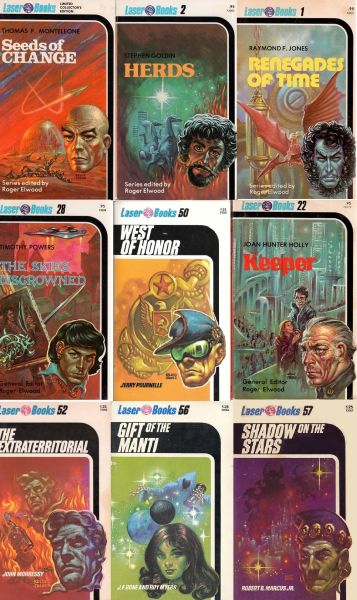Going to the Laser Show
Laser Books
Edited by Roger Elwood

1 Mar, 2020
There have been many well-intentioned but failed SFF imprints. Some we may mourn; we may remember the good books they did manage to publish and regret that they couldn’t publish more. Some we may not mourn: imprints such as Laser Books.
This line was launched by romance powerhouse Harlequin Books in 1975. Laser set out to publish three titles per month, which was impressive in those pre-computer, pre-internet days. Harlequin hired a seasoned professional — more of him anon — to edit the line, and employed Hugo-winning artist Frank Kelly Freas to produce covers that would give the line a consistent, crowd-pleasing look. Laser was set to take the SF world by storm with a line whose consistent appearance and content would appeal to readers looking for the SFnal equivalent of breakfast cereal, the same experience in every bowl. Or so Harlequin hoped.
The first Laser novel, Thomas Monteleone’s Seeds of Change, was given away, gratis, to bookstores and at conventions. The book was ubiquitous. The only reason that I did not have a copy foisted on me was that I lived in Waterloo, a backwater notable for having once voted down electrification1.
Having won readers’ attention with the giveaway, Laser then began to crank out books. Authors were provided with stringent content guidelines by branding-conscious Harlequin, who applied the experience gained conquering the field of romance to the field of SF. The books were to be inoffensive and of reliable quality. Just like their romance novels. What could go wrong?
They picked competent authors. Some of them were already well-known; some became well-known later; some remained obscure. None were Lionel Fanthorpes, churning out pulp by the word. A few of their authors: Gordon Eklund, Raymond F. Jones, Stephen Goldin, George Zebrowski, Jerry Pournelle, J. T. McIntosh, Joseph Green, and Timothy Powers.
It must be admitted that the aforementioned gained fame for works that either pre-date or post-date their work for Laser.
The Freas covers were also not at fault. The Laser covers might not have been his best work, but they were always competent.
No, I think Laser’s failure has to be attributed to their narrow guidelines and their editor, Roger Elwood. Elwood was certainly a seasoned professional, having left quite a mark on the science fiction anthology field. Unfortunately for Harlequin, that mark was along the lines of the mark left on Bikini Atoll by Operation Castle.
Elwood had helmed a handful of OK-selling SF anthologies. He built on his success, contracting with several publishers and many authors to fill dozens of themed anthologies, all of which were released in 1973 and 1974. To give some idea of the scale of his efforts, it is estimated that his anthologies may have accounted for a quarter of the short story market at the time. Quality was … variable… and the effect on salability of themed anthologies was not necessarily to the benefit of themed anthologies.If SF readers of the time had been aware of the anthology debacle, if they had known that Elwood was in charge at Laser, they would have been rightly dubious of the quality of the line.
It wasn’t just Elwood’s spotty history. His authors complained of editorial tampering. This might have been inevitable regardless of who the editor was, given that Harlequin was applying the same rigid model that had worked so well for them in romance [5] to SF. Also (and this may come as a bit of a shocker) it turns out that many writers have complained about editors at many publishing houses. Kvetching at editors (and book covers) is a venerable custom6.
The rules had one effect: any given Laser book was of consistent quality. That quality was mediocre. Bland. Not especially noteworthy but inoffensive. This, in a decade when a lot of exciting ground-breaking work was being published. Readers could be assured of a consistent experience when they picked up a Laser book. But it wasn’t an interesting experience.
Laser folded in 1977, having published an impressive fifty-eight books7 in just a few years. This tidal wave of SF has for the most part disappeared into obscurity. The moral might be that SF readers don’t in fact want nice, bland, predictable Nutty Nuggets after all.
1: I exaggerate slightly: I lived _adjacent_ to Waterloo, a backwater most notable for once having voted down electrification, near the thriving rural community of Josephsburg2.
2: Well, adjacent to the thriving rural community of Josephsburg3. Midway between it and the thriving rural community of Berlett’s Corners4.
3: Technically, not so much a thriving community as an intersection that had a name for some reason. It did have a two-room, four-grade schoolhouse, though. At least until it burned down.
4: See [3] but replace “grade-school” with “desanctified church.”
5: This seems like a good place to acknowledge that romance has evolved quite a bit since the 1970s. My editor (who reads the genre) assures me that it’s better.
6. Allow me to mention here that I am blessed with EDITORS WHOSE VIRTUES ARE UNPARALLELED AND WHOSE JUDGEMENT I DO NOT QUESTION.
7: Elwood left the SF field. According to Wikipedia, he later taught at a midwestern Bible college and published more than thirty Christian novels. One of them, Ashes of Paradise (1997), explains how to reconcile Confederate slaveholding and Christian ideals. He severed his links with SF effectively enough that it took four months for the community to notice his demise in 2007.
